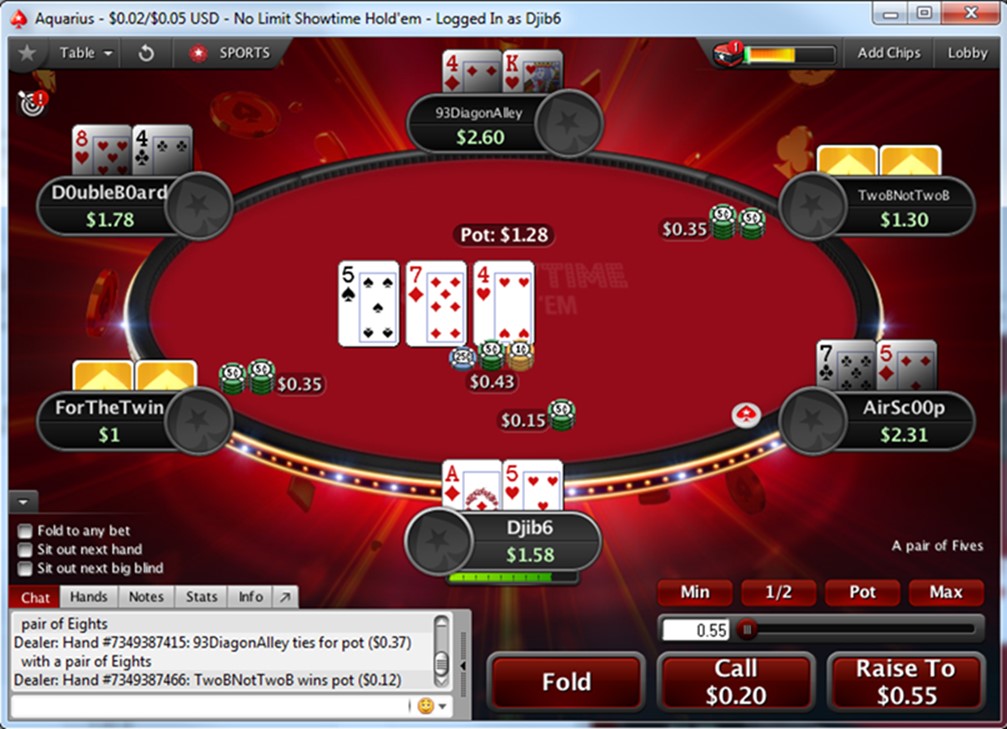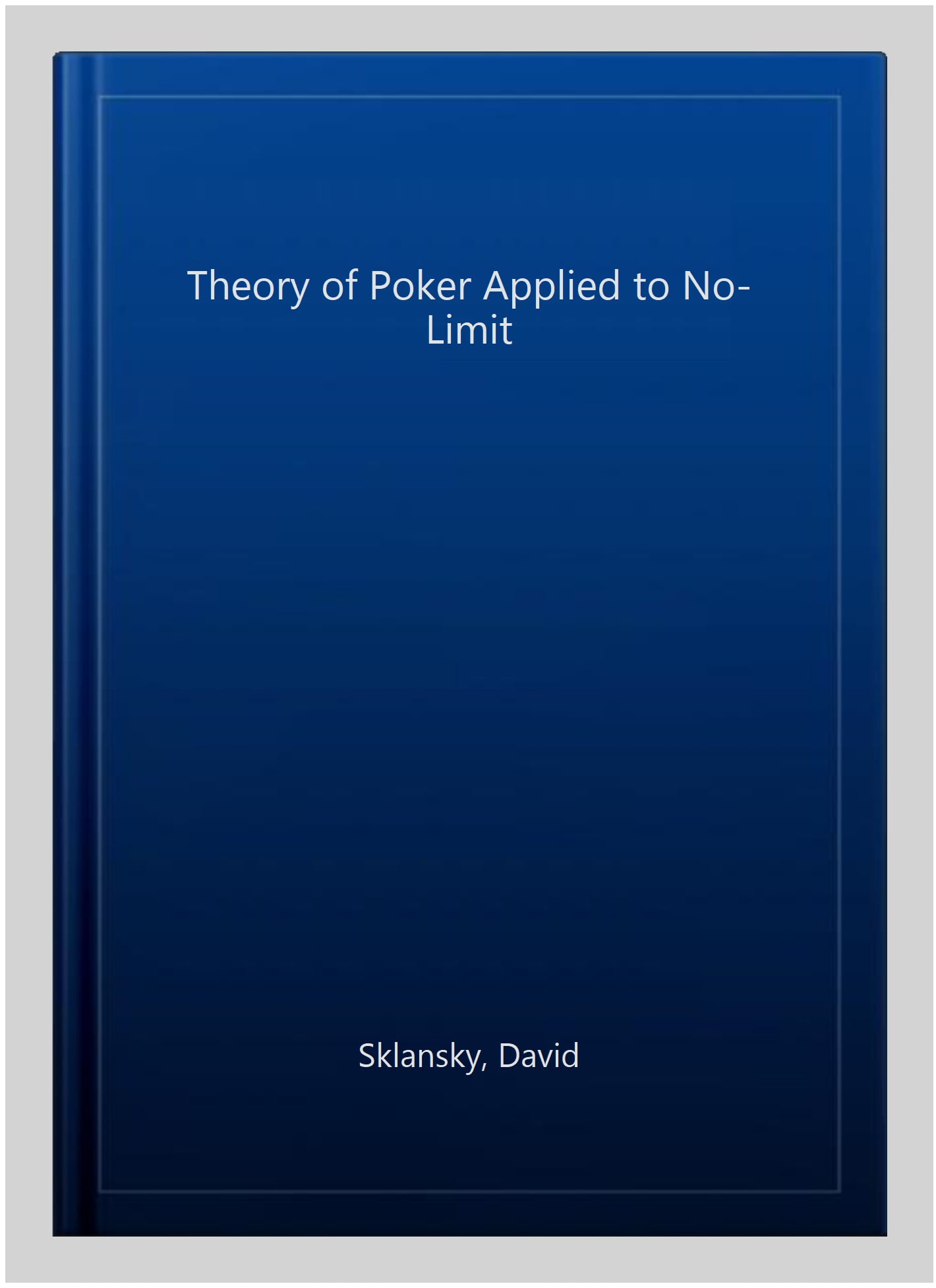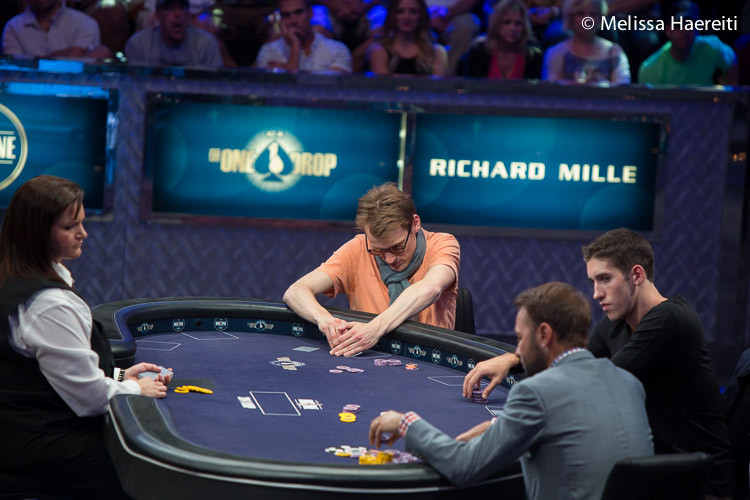Theory Of Poker
A Texas Hold'em game from a player's point of view. (Courtesy of Peter Hopper on Flickr. License CC BY-NC.)
Instructor(s)
Poker, blackjack, other casino games, sports betting, and general gambling concepts. This book contains some of the most sophisticated gambling ideas that have ever been put into print. The Theory of Poker By David Sklansky A product of Two Plus Two Publishing FOURTH EDITION SEVENTH PRINTING April 2005 Printing and ind gCr el Printing Co. The Theory of Poker by David Sklansky has long been recognized as the foundational book for all of poker no matter what the game, and at the time of this writing is still the best selling book in poker.
Kevin Desmond
MIT Course Number
15.S50
As Taught In
January IAP 2015
Level
Graduate
Some Description | |
Instructor(s) | Prof. |
As Taught In | Spring 2002 |
Course Number | 2.24 |
Level | Undergraduate/Graduate |
Features | Lecture Notes, Student Work |
Welcome!
This is one of over 2,400 courses on OCW. Explore materials for this course in the pages linked along the left.
MIT OpenCourseWare is a free & open publication of material from thousands of MIT courses, covering the entire MIT curriculum.
No enrollment or registration. Freely browse and use OCW materials at your own pace. There's no signup, and no start or end dates.
Knowledge is your reward. Use OCW to guide your own life-long learning, or to teach others. We don't offer credit or certification for using OCW.

Made for sharing. Download files for later. Send to friends and colleagues. Modify, remix, and reuse (just remember to cite OCW as the source.)
Learn more at Get Started with MIT OpenCourseWare
Course Description
Course Features
Educator Features
Course Description
This course takes a broad-based look at poker theory and applications of poker analytics to investment management and trading.
This course is offered during the Independent Activities Period (IAP), which is a special 4-week term at MIT in January. IAP provides members of the MIT community including students, faculty, staff, and alums with an opportunity to organize, sponsor and participate in a wide variety of activities and topics that are often outside of the regular MIT curriculum.


Faculty Advisor: Paul Mende
Other Versions
Other OCW Versions
OCW has published multiple versions of this subject.
Related Content
Course Collections
See related courses in the following collections:
Find Courses by Topic
Read an Excerpt
Check Raising
Modern Theory Of Poker

Check raising and slowplaying are two ways of playing a strong hand weakly to trap your opponents and win more money from them. However, they are not identical. Check raising is checking your hand with the intention of raising on the same round after an opponent bets. Slowplaying, which we discuss in more detail in the next chapter, is playing your hand in a way that gives your opponents no idea of its strength. It may be checking and then just calling an opponent who bets, or it may be calling a person who bets ahead of you. When you slowplay a hand, you are using deception to keep people in for a while in order to make your move in a later round. Clearly, then, a hand you slowplay has to be much stronger than a hand with which you check raise. Check raising can drive opponents out and may even win the pot right there, while slowplaying gives opponents either a free card or a relatively cheap card.
THE ETHICS OF CHECK RAISING
There are some amateur poker players who find something reprehensible about check raising. They find it devious and deceitful and consider people who use it to be less than well bred. Well, check raising is devious and it is deceitful, but being devious and deceitful is precisely what one wants to be in a poker game, as is implied by the Fundamental Theorem of Poker.

Checking with the intention of raising is one way to do that. In a sense, check raising and slowplaying are the opposites of bluffing, in which you play a weak hand strongly. If check raising and slowplaying were not permitted, the game of poker would lose just about as much as it would if bluffing and semi-bluffing were not permitted. Indeed the two types of play complement one another, and a good player should be adept at both of them. The check raise is a powerful weapon. It is simply another tool with which a poker player practices his art. Not allowing check raising in your home game is something like not allowing, say, the hit and run in a baseball game or the option pass in a football game. Without it poker loses a significant portion of its strategy, which, apart from winning money, is what makes the game fun. I'm much more willing to congratulate an opponent for trapping me in a check raise than for drawing out on me on a call he shouldn't have made in the first place - and if I am angry at anyone, it is at myself for falling into the trap.
NECESSARY CONDITIONS FOR CHECK RAISING
Two conditions are needed to check raise for value - that is, when you expect you might be called by a worse hand. First, you must think you have the best hand, but not such a great hand that a slowplay would be proper. Second, you must be quite sure someone behind you will bet if you check. Let's say on Fourth Street in seven-card stud someone bets with ? ? Qd 10sshowing, and with Kc 9d 9h Jsyou're getting sufficient pot odds to call. Now on Fifth Street you catch a king to make kings up. Here you might check raise if you are pretty sure the player representing queens will bet.
This second condition - namely, that someone behind you will bet after you check - is very important. When you plan to check raise, you should always keep in mind that you could be making a serious, double-edged mistake if you check and no one bets behind you. You are giving a free card to opponents who would have folded your bet, and in addition you are losing a bet from those who would have called. So you had better be very sure the check raise will work before you try it.
CHECK RAISING AND POSITION
When you plan to check raise with several players still in the pot, you need to consider the position of the player you expect will bet because that position determines the kind of hand you check raise with, to a large extent. Let's say you have made hidden kings up on Fifth Street, and the player representing queens is to your right. Kings up is a fairly good hand but not a great hand, and you'd like to get everybody out so they don't draw out on your two pair. You check, and when the player with queens bets, you raise. You are forcing everyone else in the hand to call a double bet, the original bet and your immediate raise, and they will almost certainly fold. You don't mind the queens calling your raise, for you're a big favorite over that player. However, if he folds, that's fine too.
Now we'll place the player representing queens to your left instead of to your right. In this case you should bet with kings up even though you know the player with queens will bet if you check and even though you think you have the best hand. When you bet in this spot, you are hoping the queens will raise so that the double bet will drive out the other players in the pot, just as your check raise was meant to do in the other instance. And if that opponent does raise, you can now reraise.
Suppose that instead of kings up, the king on Fifth Street gives you three kings. Now you are much stronger than you were with two pair, and your hand can tolerate callers. Therefore, you would use the opposite strategy you employed with kings up. With the probable bettor to your right, you should bet, and after everyone calls, you hope that bettor raises so that people will be calling a single bet twice (which they are much more likely to do than to call a double bet once). On the other hand, if the probable bettor is to your left, then you check the three kings, and after that player bets and everyone calls, you raise. Once again, you are inviting your opponents to call a single bet twice and not a double bet once.
In sum, the way you bet or check raise depends on the strength of your hand in relation to what you can see of the other hands and the position of the player you expect to bet or raise behind you when you check or bet. With a fairly good hand, like kings up or aces up in seven stud, you try to make opponents call a double bet because you'd like to drive them out. With a very good hand like three kings or three aces you play to induce your opponents to call a single bet; then you confront them with having to call another single bet. In this case, you don't mind their staying in since you're a big favorite over them.
CHECK RAISING WITH A SECOND-BEST HAND
While you generally check raise because you think you have the best hand, it is frequently correct to check raise with a second-best hand if the play will drive other opponents out. The principle here is identical to the principle of raising with what you think is the second-best hand as it was explained in Chapter Nine and Chapter Thirteen. If the probable best hand is to your immediate right, you can check, wait for that player to bet, then raise so that the rest of the table will fold rather than call a double bet. While you may not be the favorite, you have still increased your chances of winning the pot, and you have the extra equity of whatever dead money is in the pot from earlier betting rounds.
Game Theory Optimal Poker
Sometimes you can check raise with a come hand like a four flush if there are many people in the pot already and you don't expect a reraise, for you are getting good enough odds, especially if you have a couple of cards to come. This play should usually be made only when the probable bettor is to your immediate left; then the other players will call that bettor before they realize you are putting in a raise. You do not want to drive players out because you want to get the correct odds for your raise.
SUMMARY
The factors you must consider when you plan to check raise are:1. The strength of your hand2. Whether someone behind you will bet after you check3. The position of the probable bettor
Theory Of Poker Review
To check raise with a hand with which you want to thin out the field, you want the probable bettor to your right so that people will have to call a double bet to stay in. With a very strong hand and with most come hands, you want the probable bettor to your left so the other players in the hand might call that bettor's single bet and then be invited to call your raise.